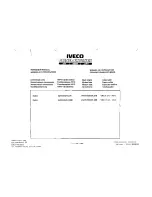
GB D
DK E
F GR I
N
NL P
S
SF
3
Checking or Adding Oil
CAUTION:
To check oil, engine must be level,
with oil fill facing up. if not level, dipstick reading
will not be accurate and could lead to possible
over/under filling of oil. This may lead to possible
engine damage.
•
Check oil level
before
starting the engine.
•
Check oil level before every use.
•
Keep oil level at FULL.
•
DO NOT overfill, use oil measure cup for filling.
•
Add only 30ml (1 oz)
➊
_-- 15ml (0.5 oz)
➋
of oil at
a time.
Fig. 3
➊
➋
OIL PROCEDURE
1. Place engine level. Remove dipstick. Using oil
measure cup, pour oil slowly. Do not overfill.
➊
.
Note:
Engine holds approximately
90 ml.
2. To check oil level, remove dipstick and wipe clean
with cloth. Replace dipstick and tighten down.
3. Remove and check oil level. Level should be at
FULL mark.
➋
4. Verify FULL level of oil by the presence of oil in
hole on dipstick, or by measure line.
5. If oil is required, add 15ml (0.5oz) oil at a time.
Recheck level.
FUEL RECOMMENDATIONS
Use clean, fresh, lead-free gasoline with a minimum of
85 octane. Leaded gasoline may be used if it is
commercially available and if unleaded is unavailable.
Purchase fuel in quantity that can be used within 30
days. See
Storage
.
In U.S.A. leaded gasoline may not be used. Some
fuels, called oxygenated or reformulated gasolines, are
gasolines blended with alcohols or ethers. Excessive
amounts of these blends can damage the fuel system
or cause performance problems. If any undesirable
operating symptoms occur, use gasoline with a lower
percentage of alcohol or ether.
This engine is certified to operate on gasoline. Exhaust
Emission Control System: EM (Engine Modifications).
Do not use gasoline which contains Methanol. Do not
mix oil with gasoline.
For engine protection, we recommend using Briggs &
Stratton Fuel Stabilizer available from an Authorized
Briggs & Stratton Service Dealer.
ADDING FUEL
Fig. 4
Tilt engine at angle shown to properly refuel. Clean
around fuel fill before removing cap. Fill tank to
approximately 1-1/2 inches below top of neck to allow
for fuel expansion. Be careful not to overfill.
WARNING
Before refueling, allow
engine to cool 2 minutes.
STARTING
WARNING
CAUTION
Check oil level before starting engine. Oil level
should be at Full mark on dipstick before starting
engine. If started without oil, engine damage will
occur.
CAUTION
Operating engine at an excessive speed without
proper engine loading will cause damage. Do not
operate a string trimmer with a line shorter than 10”
(25 cm) diameter.
STARTING THE ENGINE
Fig. 5
1.
Add oil and fuel as instructed in this manual.
2. Push
➊
primer bulb
15
times
FOR NEW
ENGINE
,
8
times for all consecutive starts.
3. Red choke lever
➋
should be in the FULL
CHOKE
➌
position.
4. Squeeze throttle trigger
➍
and pull starter handle
➎
sharply until engine runs.
5. Wait a maximum 10 seconds, then move choke
lever to HALF CHOKE
➏
position.
6. Run the engine at HALF CHOKE for 20 seconds
or until unit accelerates smoothly. Move choke to
OFF
➐
position. (Colder temperatures will
require a longer warm-up period on HALF
CHOKE)
7. Wait a minimum of 20 seconds, then release
throttle trigger.
STARTING A WARM ENGINE
H
Follow steps under Starting, with the exception of
squeezing throttle trigger. It is not necessary to
squeeze and hold throttle trigger to restart a warm
engine.
STOPPING
Fig. 5
•
Depress stop switch
➑
to stop engine.
WARNING
DO NOT close choke to
stop engine.
MAINTENANCE
WARNING
To prevent accidental starting, remove
spark plug wire and ground it before
servicing.
Regular maintenance improves performance and
extends engine life. More frequent service is required
when operating in adverse conditions.
See any Authorized Briggs & Stratton Service Dealer
for correct replacement parts. Other parts may not
perform as well, may damage the engine, result in
injury, or void your warranty.
Do not strike the flywheel with hammer or hard
object. If done, the flywheel may shatter during
operation.
Do not tamper with links or other parts to increase
engine speed.
WARNING
Follow the hourly or calendar intervals, whichever
occur first. More frequent service is required when
operating in adverse conditions noted below.
Before Every Use
D
Check oil level
First 4 Hours
D
Change oil
Every 8 Hours or Every Season
D
Change oil
D
Service air cleaner
*
Every 50 Hours or Every Season
D
Replace spark plug**
D
Check valve clearance
*
Clean more often under dusty conditions, or when
airborne debris is present or after prolonged operation
cutting tall, dry grass.
**
In some areas, local law requires using a resistor spark
plug to suppress ignition signals. If this engine was
originally equipped with resistor spark plug, use same
type of spark plug for replacement.
CHANGING OIL
& CHECKING LEVEL
Fig. 6
1. Change oil while the engine is warm, ensure fuel
cap is tightened securely.
2. Remove dipstick, and drain oil
➊
in direction
shown.
3. Place engine level. Using oil measure cup pour oil
slowly adding 0.5 oz. at a time
➋
. Do not overfill.
Note:
Engine holds approximately
90 ml.
4. To check oil level, remove dipstick and wipe clean
with cloth. Replace dipstick and tighten down.
5. Remove and check oil level. Level should be at
FULL mark.
➌
6. Verify FULL level of oil by the presence of oil in
hole on dipstick, or by measure line.
7. If oil is required, add 15ml (0.5oz) oil at a time.
Recheck level.
8. Replace dipstick tightly before starting engine.
Summary of Contents for Fource 21000
Page 21: ...Fig 5 Fig 6 Fig 7 Fig 8...






































